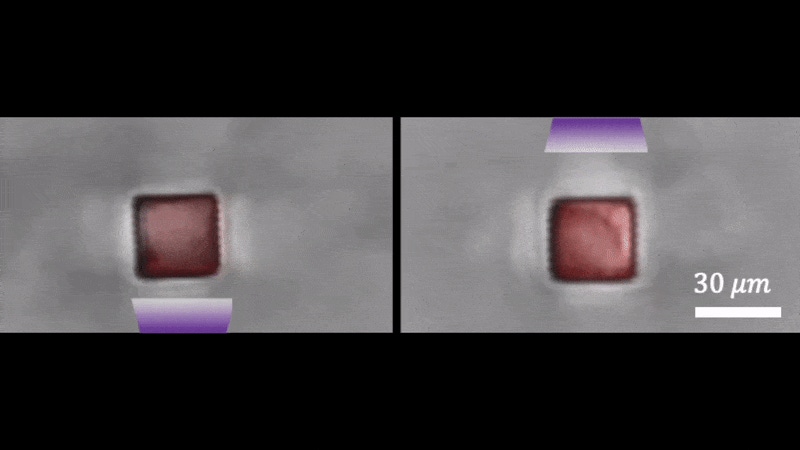Elastomers Programmed to Twist in Response to Light
New materials could enable soft robots to move similarly to human muscles without the use of complex electronic systems for actuation.
May 27, 2020

Materials that can move autonomously in response to external stimuli are attractive to scientists for applications such as robotics that normally require complex systems and motors to create actuation and movement.
A collaboration between scientists at the University of Pittsburgh (Pitt) and Harvard University have developed a new candidate for these type of materials with the creation of a new liquid crystal elastomer (LCE) that can be “programmed” to both twist and bend in the presence of light, reacting to the stimulus with movements similar to human muscles.
|
Experimental observations of twisting of surface-anchored liquid crystal elastomer (LCE) microposts that reversibly twist clockwise and counterclockwise, with handedness controlled by the direction of incident light, as predicted by the simulations. Researchers at the University of Pittsburg and Harvard University developed these new LCEs, which they said can be used in soft robotics. (Image source: Aizenberg Lab, Harvard University) |
The materials developed by a team led by researchers at Pitt’s Swanson School of Engineering have a unique characteristic—they are achiral, which means their structure and mirror image are identical.
This lends the material some interesting properties especially for twisting and bending in response to light, a key behavior of the new elastomers, said Anna C. Balazs, distinguished professor of chemical and petroleum engineering at Pitt, who co-led the research.
“The chirality of molecules and materials systems often dictates their properties,” she said in a press statement. “The ability to dynamically and reversibly alter chirality or drive an achiral structure into a chiral one could provide a unique approach for changing the properties of a given system on-the-fly.”
Dynamic Design
A human hand, for example, is a chiral object; its shape is not superimposable on a mirror image of itself so, obviously, a right hand cannot be automatically converted to a left hand.
The LCE the researchers developed, however, can—after light exposure—controllably and reversibly twist to the right or twist to left, forming both right-handed and left-handed structures.
To discover the behavior of the elastomers they created, researchers used computer modeling of a microscopic LCE post anchored to a surface in air. Through their experiments, they observed that molecules that extend from the LCE backbone are aligned at 45 degrees--with respect to the surface--by a magnetic field, and that the LCEs are cross-linked with a light-sensitive material.
“When we simulated shining a light in one direction, the LCE molecules would become disorganized and the entire LCE post twists to the left; shine it in the opposite direction and it twists to the right,” said James Waters, a postdoctoral associate who also worked on the research. Collaborators from Harvard corroborated these experimental findings, he said.
Material Puppeteering
The team also used their validated computer model to design “chimera” LCE posts in which the molecules in the top half of the post are aligned in one direction and the molecules on the bottom are aligned in another direction. When light was applied to the structures, they bent and twisted similar to how human muscles work in response to nerve stimuli.
“This is much like how a puppeteer controls a marionette, but in this instance the light serves as the strings, and we can create dynamic and reversible movements through coupling chemical, optical, and mechanical energy,” Balazs said in a press statement.
This characteristic of the material could be key to helping researchers create more human-like soft robots that mimic human muscle movements without using complicated systems of actuation, she said.
“Being able to understand how to design artificial systems with this complex integration is fundamental to creating adaptive materials that can respond to changes in the environment,” Balazs said in a press statement. “Especially in the field of soft robotics, this is essential for building devices that exhibit controllable, dynamic behavior without the need for complex electronic components.”
Elizabeth Montalbano is a freelance writer who has written about technology and culture for more than 20 years. She has lived and worked as a professional journalist in Phoenix, San Francisco and New York City. In her free time she enjoys surfing, traveling, music, yoga and cooking. She currently resides in a village on the southwest coast of Portugal.
About the Author(s)
You May Also Like




